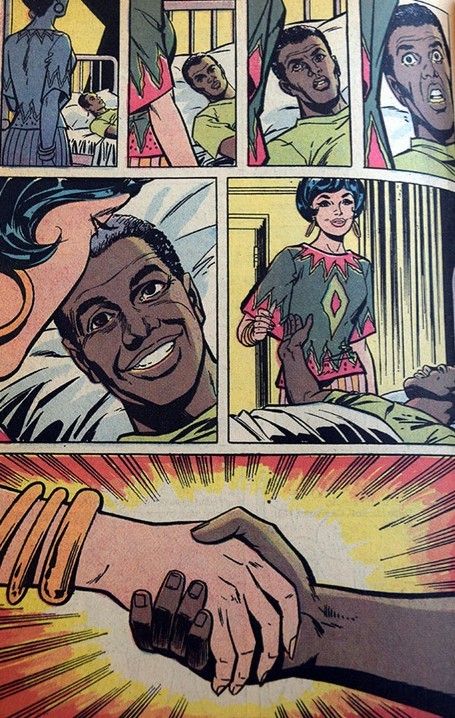In the final pages of Superman’s Girlfriend Lois Lane: I Am Curious (Black), Dave’s reaction to Lois Lane’s transformation back to white from black highlights the idea of interracial friendship as a means to end racism.
In these panels, Lois visits Dave, a black man whom she gave a blood transfusion, in the hospital. As she is speaking with him, she begins to change back to white earlier than expected and she becomes nervous that Dave will be upset when he sees her true identity. It is notable that this last scene plays out entirely on the two characters’ faces and is absent of any dialogue. Dave’s facial expression changes from confusion to either horror or surprise, and then to a wide smile before the pair grasps hands in front of a burst of light.
This ending ties back to the idea of setting aside mutual prejudices in the name of friendship and acceptance. The attitude that friendship is the path to end racism was often taken in the biracial “buddy films” that arose in Hollywood in the 1960’s and 1970’s, around the same time as this comic was published. In these films, a white man and a black man come together as an unlikely pairing to solve a problem. Dave and Lois’ interracial handshake is a common symbol in the buddy films, signifying unity across races and progress (Daniels). However, unlike the buddy films, Lois’s story also breaches the taboo of a white woman interacting with a black man. Lois and Dave’s interaction is relatively brief and nonsexual, with Superman present for most of it. In many of the “buddy films,” black men’s sexuality was eliminated in favor of “sterile paragons of virtue,” and the white man’s presence in this particular instance can be read as a reminder that the black man is inferior (Guerrero 72). In many of the “buddy films,” black men’s sexuality was eliminated in favor of “sterile paragons of virtue,” and the white man’s presence in this particular instance can be read as a reminder that the black man is inferior (Guerrero 72). Here, Superman’s presence in the hospital room inherently protects Lois’ virtue while at the same time establishing his superiority to Dave.
In the earlier scenes of the comic, Lois’s blood transfusion to Dave, who had formerly proclaimed her his “enemy,” also reiterates the idea that if everyone were to put aside differences and come together, then racism would vanish. As Lois worries about Dave’s reaction to finding out that she is white, Superman tells Lois, “If he still hates you, with your blood in his veins, there may never be peace in this world!” Superman’s comment alludes to the popular and problematic “colorblind” idea of “we all bleed red,” which ignores race and sees only humanity.
Even though Lois and Dave form a friendship, it is not enough to change the structures in place that are seen in other parts of the comic, such as rampant poverty and poor school systems, as well as the sexism that exists throughout. In the story, Lois experiences many instances of sexisism, such as when she is told to stay behind from the crime scene, when she is concerned with her “black outfit,” and when she plays submissive partner to Superman. Right before her transformation back to white, Lois asks Superman if he would still marry her if she were black. This interaction solidly places Lois in the realm of an obedient woman who desires a white man, regardless of her own race. These factors are overlooked and even upheld by Lois’s story, making the charming happily-ever-after of her and Dave’s hands together misleadingly optimistic.
Daniels, Melissa. "The Color Line And The Silver Screen: Sidney Poitier, Liberal Hollywood, And Racial Integration In Stanley Kramer's The Defiant Ones and Norman Jewison's In The Heat Of The Night." Americana. Americana: The Institute for the Study of American Popular Culture, Jan. 2007. Web. 04 May 2015.
Guerrero, Ed. "The Rise and Fall of Blaxploitation." Framing Blackness: The African American Image in Film. Philadelphia: Temple UP, 1993. PDF.
